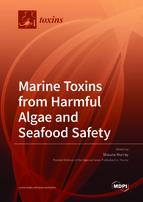Marine Toxins from Harmful Algae and Seafood Safety
A special issue of Toxins (ISSN 2072-6651). This special issue belongs to the section "Marine and Freshwater Toxins".
Deadline for manuscript submissions: closed (31 December 2021) | Viewed by 44624
Special Issue Editor
Interests: harmful algal blooms; qPCR; phylogenetics; evolution; molecular ecology; benthic dinoflagellates; systematics
Special Issues, Collections and Topics in MDPI journals
Special Issue Information
The rapid expansion of aquaculture around the world is increasingly impacted by toxins produced by harmful marine microalgae, which threaten seafood safety. In addition, ocean climate change is leading to changing patterns in the distribution of toxic dinoflagellates and diatoms that produce these toxins. New approaches are being developed to monitor for harmful species and the toxins they produce. This Special Issue will cover new research on harmful marine microalgae and their toxins, including the identification of species and toxins; the development of new chemical and biological techniques to identify and monitor species and toxins; marine biotoxin uptake in seafood and marine ecosystems; and the distribution and abundance of toxins, particularly in relation to climate change.
Prof. Dr. Shauna Murray
Guest Editor
Manuscript Submission Information
Manuscripts should be submitted online at www.mdpi.com by registering and logging in to this website. Once you are registered, click here to go to the submission form. Manuscripts can be submitted until the deadline. All submissions that pass pre-check are peer-reviewed. Accepted papers will be published continuously in the journal (as soon as accepted) and will be listed together on the special issue website. Research articles, review articles as well as short communications are invited. For planned papers, a title and short abstract (about 100 words) can be sent to the Editorial Office for announcement on this website.
Submitted manuscripts should not have been published previously, nor be under consideration for publication elsewhere (except conference proceedings papers). All manuscripts are thoroughly refereed through a double-blind peer-review process. A guide for authors and other relevant information for submission of manuscripts is available on the Instructions for Authors page. Toxins is an international peer-reviewed open access monthly journal published by MDPI.
Please visit the Instructions for Authors page before submitting a manuscript. The Article Processing Charge (APC) for publication in this open access journal is 2700 CHF (Swiss Francs). Submitted papers should be well formatted and use good English. Authors may use MDPI's English editing service prior to publication or during author revisions.
Keywords
- Marine harmful algae
- Gambierdiscus
- Alexandrium
- Dinophysis
- Pseudo-nitzschia
- ciguatoxin
- saxitoxin
- okadaic acid
- domoic acid
- paralytic shellfish toxins







